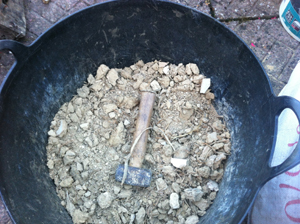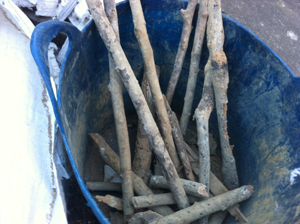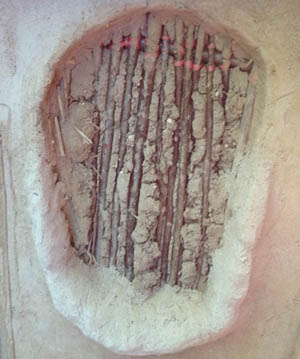
Recycling daub from the 1400s!

Sticks that have been encased in clay
daub since the 1400s. They are remarkably
well preserved for 600 year old sticks!

New wattle and daub with honesty panel.
Wattle tied in place with
upcycled baler twine.
|
|
|
|
|
|
|
Repairing the Past 23rd June 2018
I’ve been asked to
repair a vintage daub panel. It’s in a
medieval timber frame house, grade 2 and jettied. This beautiful
building was
first constructed around the time of Henry V111th when the lane
outside conveyed horse and cart. The house fronts a busy road now and
six weeks
ago an unsuspecting lorry driver failed to spot the overhang and
smashed into
it breaking 500 year old timbers and jolting the daub panels out of
true.
Recycling the old
daub
So, I went for a site meeting
with the builder, surveyor,
carpenter and owner and we talked a lot about conserving as much of the
historic fabric of the building as possible. I asked that they keep me
any daub
that had to be removed because the old daub is the best. It has
weathered for
centuries and mixes up a treat for re-use.
Replacing the
wattle
frame
The veteran hazel rods fair
less well. Having been cased in
clay they are remarkably good for their age, but re-use is impractical.
I will
need green hazel with more bounce and flex than these dry relics have!
Using materials
sympathetic to the building
I’m excited to be asked to
undertake this job. It so easily
could have been fixed with plasterboard and gypsum that are so alien to
the
timber frame and do it a great dis-service. The intention is to enable
the
building to breathe and render the daubed panels inside and out with
lime.
The proposed time-scale slips
a little as do all good
building projects. I’m in no hurry, this is one to savour, and besides
I live
in a totally different era anyway. What worries me a little is the
cutting of
the hazel in full leaf. That doesn’t feel right. I would prefer to cut
it in
the late winter, but even with a bit of slippage this repair job needs
doing
this summer. So off I trundle to source new wattle framing.
Sourcing the
hazel
rods
I need 5-6 rods per 14” wide
panel. They need to be straight
with some bounce in them. I’m happy in my natural habitat with just my
trusty
billhook for company. I was fussing about the length of the panels
until it
realised that the hazel would help me with that. The quickly grown rods
were
coming out at 2 metres, and that was just the right length to
comfortably go in
my vehicle. Mostly they were one-years’ growth of 1” diameter, but I
also
harvested some stouter poles. These I plan to use for the horizontal
spars that
hold the rest of the verticals in place.
Fixing the wattle
frame
My mind strays to string.
Whilst I’d love to make Willow
Herb or Nettle string, I’m going to compromise and make good
use of
preloved baller string. That way when they come to renew the panel in
another
500 years future archaeologist will be able to date my work. Have a look at the original Lime Bast ties.
Will I plant a time capsule
in one of the panels? Subscribe to the Orchard Barn e-news to find out.
|
|